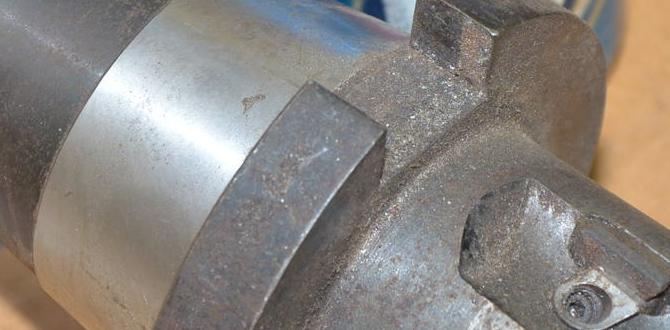Tialn Ball Nose End Mills are the go-to choice for machining deep slots in brass. Their specialized coating and geometry excel at controlling heat and chip evacuation, preventing tool wear and ensuring clean, precise results in this softer, gummy material.
Ever tried to mill a deep slot in brass and ended up with a mess? It’s a common frustration for machinists. Brass can be tricky stuff – soft enough to gum up conventional tools but hard enough to cause wear if you’re not using the right gear. Getting a clean, deep cut without melting your workpiece or breaking your end mill can feel like a real challenge. Don’t worry, though! There’s a specific tool designed to make this job much smoother. We’re talking about the Tialn ball nose end mill, and when paired with the right approach, it’s your best friend for brass deep slots. Stick around, and we’ll walk you through exactly why and how to use it like a pro!
Why Brass Can Be a Headache for Machining
Brass, a popular alloy of copper and zinc, is loved for its workability, corrosion resistance, and attractive appearance. It’s a staple in many industries, from plumbing and hardware to musical instruments and decorative items. However, its machining characteristics can be a bit of a mixed bag, especially for beginners.
The main challenge with brass is its tendency to be “gummy.” This means it can stick to the cutting edges of your tools, leading to:
- Poor surface finish: The material smears rather than cuts cleanly.
- Increased friction and heat: This can dull your tools faster and even deform the workpiece.
- Chip welding: Small chips adhere to the cutting edge, effectively making the tool “bigger” and creating more heat and drag.
- Tool breakage: If the tool snags due to chip buildup, it can snap, especially on delicate or smaller end mills.
When you’re trying to cut deep slots, these issues are amplified. There’s less room for chips to escape, and the tool spends more time in contact with the material, generating more heat. This is precisely where the right tooling makes all the difference in the world.
Introducing the Tialn Ball Nose End Mill
So, what makes the Tialn ball nose end mill (often specifically referring to a coating) so effective for this particular task? Let’s break it down. The “Tialn” typically refers to a Titanium Aluminum Nitride coating. This isn’t just any coating; it’s a high-performance ceramic layer that brings some serious advantages to the CNC world.
A ball nose end mill, by its design, has a hemispherical tip. This shape is fantastic for creating rounded internal corners and for cutting complex 3D contours. When you combine this shape with a specialized coating like Tialn, you get a tool that’s built for demanding applications.
The Magic of the Tialn Coating
The Tialn coating is a game-changer. It’s made up of layers of titanium, aluminum, and nitrogen. Here’s why it’s so good for machining tougher materials or dealing with problematic ones like brass:
- High Hardness: Tialn is extremely hard, resisting wear and abrasion, which extends the tool’s life significantly.
- Excellent Heat Resistance: It can withstand very high cutting temperatures (often over 800°C or 1472°F) without losing its structural integrity or protective qualities.
- Oxidation Resistance: This coating forms a protective aluminum oxide layer at high temperatures, which further shields the tool.
- Reduced Friction: It creates a smoother surface on the cutting edge, allowing chips to flow away more easily and reducing the tendency for material to stick (like the gumminess of brass).
For brass, this means the Tialn coating helps prevent the material from welding to the end mill, keeps the cutting edges sharp for longer, and manages the heat generated during deep slotting. This leads to cleaner cuts and a more reliable machining process.
Ball Nose Geometry for Deep Slots
The “ball nose” shape is critical. Unlike flat-end mills, a ball nose has a rounded tip. This offers several benefits:
- Smooth Transitions: It creates a radiused root in the slot, which is often stronger and less prone to stress cracks than a sharp corner.
- Better Chip Evacuation (when designed correctly): Some ball nose designs have optimized flute geometry specifically to help chips get out of the way, which is crucial in deep pockets.
- Versatility: While we’re focusing on deep slots, ball nose end mills are also excellent for profiling, 3D contouring, and creating radiused features.
When milling deep slots, the increased surface contact of a ball nose can be managed effectively with the right coating and cutting parameters, leading to a superior finish and tool longevity compared to a standard end mill for this specific deep cut application.
Why a 35-Degree Helix Angle is Often Recommended
You might have seen specifications like “Tialn ball nose end mill 35-degree.” That 35-degree angle refers to the helix angle of the flutes. The helix angle is the angle at which the cutting flutes are wrapped around the tool. It has a significant impact on how the tool cuts.
- Lower Helix Angles (e.g., 0-30 degrees): Tend to provide a more aggressive, shearing cut. They can be good for softer materials but might chatter more in harder ones.
- Higher Helix Angles (e.g., 35-45 degrees): Offer a smoother, more slicing action. They are excellent at reducing vibration and chatter, leading to a better surface finish. They’re also generally better at keeping chips pulled away from the cut, making them ideal for deeper cuts and materials prone to gumming up.
For brass, a moderate to high helix angle, like 35 degrees, is often preferred. It provides a good balance: aggressive enough to cut efficiently but smooth enough to prevent vibrations that can lead to poor finishes or tool breakage in this sometimes gummy material. This angle helps to manage the forces on the cutting edge and promotes a cleaner chip flow, which is paramount when cutting deep slots.
Key Applications for Tialn Ball Nose End Mills in Brass
The combination of a Tialn coating and ball nose geometry makes these end mills perfect for a range of tasks in brass, with deep slotting being a prime example. Here are some specific applications where you’ll find them invaluable:
- Machining Grooves and Channels: Creating precise, deep channels for fluid flow, electrical pathways, or decorative elements.
- Creating Radiused Pockets: Machining enclosed areas where a rounded bottom is required, such as in molds or custom mechanical parts.
- Engraving and Texturing: The ball nose shape allows for smooth, flowing lines and the creation of intricate patterns.
- 3D Contour Machining: While a primary focus is slots, its ability to create smooth, curved surfaces makes it suitable for any 3D machining operations on brass.
- Mold Making: In applications where a smooth, draft-free internal radius is needed, common in certain types of molds.
The ability to achieve depth while maintaining precision and a good surface finish is what sets these tools apart for brass work.
Choosing the Right Tialn Ball Nose End Mill
When you’re out shopping for your magic tool, what specifics should you look for? Beyond just “Tialn ball nose,” there are a few more details that matter:
Diameter: This is straightforward – choose a diameter that fits the width of the slot you need to machine. For deep slots, you might consider getting one slightly larger than the target slot width if you plan on taking multiple passes to step down. For example, if you need a 0.5-inch slot, you might use a 0.5-inch cutter for the bulk of the material and then a 0.25-inch ball nose to create the internal radius if a perfectly round bottom is desired (often the Ball Nose is used to cut the width of the slot). However, for creating parallel walls and a radiused bottom, you’ll select a diameter that matches your desired slot width.
Number of Flutes: For general machining, 2-flute or 4-flute end mills are common.
- 2-flute: Offers good chip clearance, which is essential for deep slots. They are less prone to clogging.
- 4-flute: Can often handle higher feed rates and provide a smoother finish due to more cutting edges engaging. However, they produce more chips, which can become an issue in deep, narrow slots if chip evacuation isn’t excellent.
For brass deep slots, a 2-flute end mill is often the safer bet initially due to better chip evacuation. If you have a very robust machine and excellent coolant/chip management, a 3- or 4-flute might work with adjusted parameters.
Coating: As we’ve discussed, look for Tialn, TiAlN, or similar advanced coatings that offer high hardness and heat resistance.
Material of the End Mill Tool Body: Most high-performance end mills are made from solid carbide. Carbide is strong, rigid, and maintains its hardness at high temperatures, making it ideal for demanding machining tasks.
Overall Length and Neck Relief: For deep slots, you’ll need an end mill with sufficient reach. Pay attention to the “effective cutting length” and look for tools with neck relief if you’re going very deep, which prevents the shank from rubbing against the workpiece.
Manufacturer Reputation: Stick with reputable brands known for quality cutting tools. Brands like Sandvik Coromant, Iscar, Kennametal, and others offer high-quality Tialn-coated ball nose end mills trusted by professionals.
Example Specification to Look For: “Solid Carbide Tialn Coated 2-Flute Ball Nose End Mill, 35-Degree Helix, 6mm Diameter, 12mm Cutting Length, 50mm Overall Length.
Essential Machining Parameters for Brass Deep Slotting
Even with the perfect tool, incorrect machining parameters can ruin your part and your tool. For brass and a Tialn ball nose end mill, here’s a general guideline to get you started. Always consult the tool manufacturer’s recommendations if available, as these are often the most accurate.
Understanding these terms is key:
- Spindle Speed (RPM): How fast the tool rotates.
- Feed Rate (IPM or mm/min): How fast the tool advances into the material.
- Depth of Cut (DOC – inches or mm): How deep each pass removes material. Deeper cuts require slower feed rates and potentially lower RPM.
- Width of Cut (WOC – inches or mm): How wide each pass is. For slotting, this is typically close to the diameter of the end mill.
- Chip Load: This is a crucial concept. It’s the thickness of the chip being removed by each cutting edge. Tool manufacturers often specify a target chip load (e.g., 0.002 inches per tooth). You calculate your feed rate using: Feed Rate = Spindle Speed × Number of Flutes × Chip Load L
Here’s a table with suggested starting parameters. Remember, these are averages. Adjustments will be needed based on your specific machine rigidity, coolant use, and the exact brass alloy.
| Parameter | Typical Value for Brass (Tialn Ball Nose, 35 deg) | Notes |
|---|---|---|
| End Mill Diameter | 0.25″ (6mm) to 0.5″ (12mm) | Choose based on slot width. |
| Flutes | 2 | Best for chip evacuation. |
| Coating | Tialn | Essential for heat and wear resistance. |
| Spindle Speed (RPM) | 2,000 – 5,000 RPM | Lower RPMs for larger diameters, slower speeds for deeper cuts. |
| Chip Load per Tooth | 0.001″ – 0.003″ (0.025mm – 0.075mm) | Crucial for preventing chip welding and tool breakage. |
| Feed Rate (IPM/mm/min) | 10 – 60 IPM (250 – 1500 mm/min) | Calculated from RPM, flutes, and chip load. |
| Depth of Cut (DOC) | 0.05″ – 0.25″ (1.2mm – 6mm) | Start shallow and increase gradually. Max DOC depends on tool length and machine power. For very deep slots, multiple passes are essential. Aim for DOC no more than 1x diameter for general slotting. |
| Width of Cut (WOC) | 80-100% of Diameter | For slotting, the cutter engages its full width. |
| Coolant/Lubrication | Recommended | Flood coolant or high-pressure spray is highly beneficial. Can use cutting fluid or wax stick if coolant isn’t available. |
A Note on Coolant
Machining brass, especially with deep cuts, generates heat. While Tialn is heat-resistant, managing heat is still key to a good finish and preventing built-up edge. Flood coolant is the best option. If flood isn’t available, a good quality cutting fluid, wax stick, or even a spray mist system can make a significant difference. It helps lubricate the cut, cool the tool and workpiece, and flush away chips.
Step-by-Step Guide: Machining Deep Slots in Brass
Let’s get hands-on. Follow these steps to mill a clean, deep slot in brass using your Tialn ball nose end mill.
1. Preparation is Key
- Secure Your Workpiece: Ensure the brass block is firmly clamped in your milling machine vise or fixture. Chatter is the enemy, and a loose workpiece is a primary cause.
- Install the End Mill: Mount the correct size Tialn ball nose end mill securely in your collet or tool holder. Ensure it’s properly seated and tightened.
- Set Your Zero Point: Accurately establish your X, Y, and Z zero points on the workpiece. The Z zero is often set at the top surface of the material.
- Consider the CAD/CAM: If you’re using CAM software, define your tool (Tialn ball nose, 2-flute, diameter, etc.) and program your slotting operation. Ensure the software is set up for the correct cutting strategy (e.g., adaptive clearing for roughing, contour for finishing).
2. Setting Roughing Parameters
We’ll start with roughing passes. These remove the bulk of the material.
- Program Initial Depth of Cut (DOC): For a medium-sized end mill (e.g., 0.25″ / 6mm), start with a DOC of around 0.05″ to 0.1″ (1.2mm to 2.5mm). For larger end mills, you might go deeper, but always err on the side of caution initially.
-
Set Spindle Speed and Feed Rate: Use the parameters from our table as a starting point. For example, if you have a 0.25″ diameter, 2-flute Tialn end mill, you might start around 3,000 RPM and calculate your feed rate. Let’s say you aim for a chip load of 0.002″ per tooth:
Feed Rate = 3000 RPM × 2 Flutes × 0.002″ = 12 IPM (inches per minute).
If machining in mm, and aiming for 0.05mm chip load:
Feed Rate = 3000 RPM × 2 Flutes × 0.05mm = 300 mm/min. - Engage Coolant: Turn on your coolant system or apply your chosen lubricant.
- Initiate the Cut: Let the machine run the first pass. Listen to the sound of the cut. A smooth hum is good; a high-pitched squeal or loud chattering indicates problems.
3. Step Down to Depth
Brass can be unforgiving if you try to take too much material at once, especially when cutting to a significant depth.







